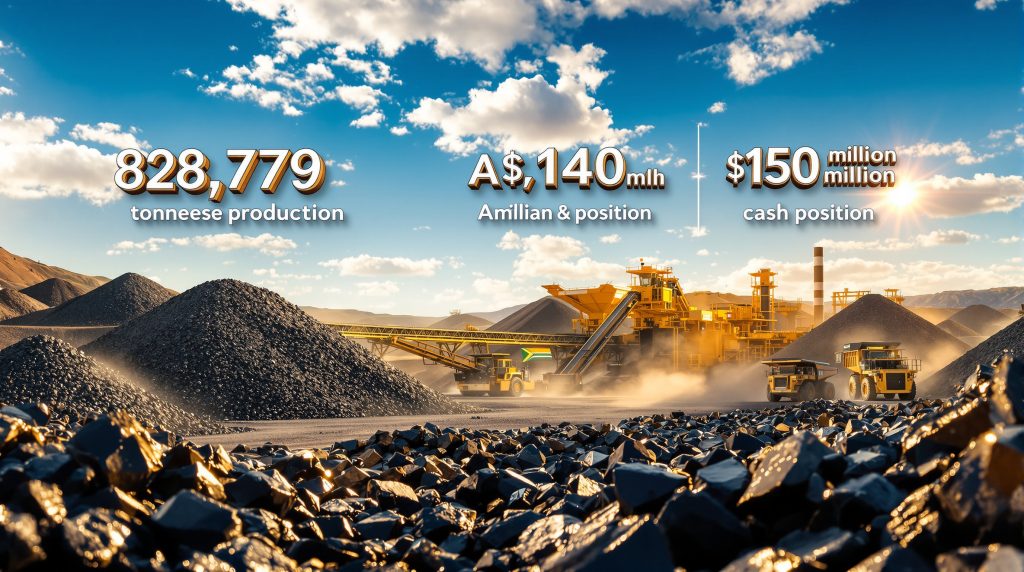Jupiter Mines Delivers Strong Q1 Performance Through Tshipi's Operational Excellence
Jupiter Mines has demonstrated robust operational consistency through its Tshipi manganese operation during the September 2025 quarter, positioning the company favourably toward achieving ambitious annual production targets. The Jupiter Mines Tshipi manganese production results showcased production volumes of 829,798 tonnes alongside sales of 837,577 tonnes for Q1 FY2026, maintaining momentum toward its 3.4-million-tonne annual guidance.
The South African operation, where Jupiter holds a 49.9% interest through its wholly-owned Jupiter Kalahari subsidiary, continues generating substantial value through disciplined cash management and operational efficiency improvements. Cash reserves increased to A$140 million during the quarter, despite distributing a R300-million final dividend to shareholders for FY2025.
Production Cost Optimization Despite Currency Headwinds
Tshipi achieved a notable 4% reduction in production costs to $2.27 per dry metric tonne unit (dmtu) on a free-on-board basis, demonstrating operational resilience against currency volatility. This improvement occurred while the South African rand strengthened against the US dollar, creating upward pressure on dollar-denominated operating expenses.
The cost efficiency gains primarily stemmed from:
• Increased volumes of graded ore mining operations
• Enhanced production throughput capabilities
• Systematic cost control initiative implementation
• Economies of scale from higher-grade ore extraction
Higher-grade ore mining volumes contributed significantly to both cost efficiency and production quality metrics, enabling the operation to maintain competitive positioning within global manganese markets. Furthermore, this strategic mining approach reflects sophisticated grade control practices that optimise both immediate operational performance and long-term resource utilisation.
Financial Performance Analysis Amid Market Variations
Q1 FY2026 Financial Metrics:
| Financial Indicator | Current Quarter | Previous Quarter | Variance |
|---|---|---|---|
| EBITDA | A$26.6 million | A$40.9 million | -35% |
| Net Profit After Tax | A$17.8 million | A$25.9 million | -31% |
| Cash Generation | A$140 million | – | Increased |
The quarterly earnings variance reflects lower sales volumes and product mix variations compared to the previous quarter, which benefited from unusually high sales volumes for that seasonal period. Industry analysts note that such fluctuations represent normal operational cycles rather than underlying performance deterioration, particularly given the seasonal nature of manganese demand patterns.
Consequently, the company's ability to maintain strong cash generation while absorbing dividend distributions demonstrates robust operational cash flow characteristics. This financial resilience provides strategic flexibility for capital allocation decisions and positions the operation well for potential market volatility.
Safety Performance Maintains Industry Leadership Standards
Tshipi continued its commitment to workplace safety excellence by recording zero lost-time injuries during the September quarter. The total recordable injury frequency rate (TRIFR) increased marginally to 0.44 from 0.38, attributed to two minor medical treatment cases that required professional attention but did not result in work time loss.
Safety Performance Indicators:
• Lost-Time Injuries: 0 incidents recorded
• TRIFR: 0.44 (slight increase from 0.38)
• Medical Treatment Cases: 2 minor incidents requiring professional care
• Safety Culture: Continued emphasis on preventive measures and training
The safety performance reflects the operation's systematic approach to risk management and worker protection protocols. Industry best practices indicate that maintaining low TRIFR rates while achieving production targets requires sophisticated safety management systems and continuous workforce engagement in hazard identification processes.
Global Manganese Market Dynamics Shape Pricing Environment
Semi-carbonate manganese ore prices experienced strengthening during the September quarter, driven by stabilised global supply conditions and robust Chinese alloy production demand. The pricing environment reflects balanced supply-demand fundamentals, with Chinese port stockpiles remaining well below historical averages.
Chinese Market Conditions:
| Market Indicator | Current Level | Historical Context |
|---|---|---|
| Port Stockpiles | 4.4 million tonnes | Below 5.8M tonne 5-year average |
| Consumption Coverage | Less than 2 months | Indicates tight supply conditions |
| Alloy Plant Absorption | Strong demand | Supporting price stability |
Strong consumption from Chinese alloy plants has absorbed increased manganese export volumes, including steady supply restoration from South32's majority-owned Groote Eylandt operation in Australia. This market absorption capacity demonstrates the underlying strength of Chinese industrial demand despite broader economic uncertainties.
However, the port stockpile levels, representing less than two months of consumption coverage at quarter-end, indicate relatively tight supply conditions that support price stability. Historical analysis suggests that stockpile levels below the five-year average of 5.8 million tonnes typically correlate with stronger pricing environments for manganese producers.
Current Market Assessment
According to Mining Weekly's latest analysis, Jupiter remains well-positioned to achieve its full-year production guidance. In addition, the company's quarterly activities report provides detailed insights into operational performance metrics.
Steel Production Trends Impact Long-Term Demand Outlook
Global steel production dynamics continue influencing manganese demand patterns, with the World Steel Association reporting continued headwinds throughout 2025. Chinese production has shown declining trends through most of the calendar year, reflecting ongoing property market challenges and reduced construction activity.
Global Steel Production Patterns:
• China: Generally declining production trend throughout 2025
• India: Strong growth driven by infrastructure and renewable energy projects
• Developed Countries: Reduced production largely offset by Indian growth
• Global Impact: Geopolitical tensions and trade disruptions affecting commodity markets
Indian steel production growth has emerged as a significant offset to declines in developed countries, driven by railway infrastructure expansion, urbanisation projects, and renewable energy initiatives. This geographic shift in steel production patterns creates both challenges and opportunities for manganese suppliers, requiring adaptive marketing and logistics strategies.
The World Steel Association's Short Range Outlook projects global steel demand to remain flat in 2025, with 1.3% growth anticipated for 2026, driven by resilient economic conditions and continued infrastructure investment.
For instance, South Africa beneficiation opportunities could enhance local value-addition strategies whilst iron ore trends & China demand continue shaping commodity market dynamics.
Market Projections and Risk Assessment Framework
Industry forecasting indicates mixed prospects for steel and manganese markets through 2026, with several key variables influencing demand trajectories. Chinese crude steel production is forecast to decline in both 2025 and 2026, primarily due to ongoing property market adjustments and reduced construction sector activity.
Growth Drivers:
• Resilient global economic conditions supporting industrial activity
• Continued strength in infrastructure investment programmes
• Easing financial market conditions improving capital availability
• Renewable energy project expansion requiring steel inputs
Risk Factors:
• Global trade environment uncertainties affecting commodity flows
• Chinese local government financial pressures constraining spending
• Geopolitical tensions creating supply chain disruptions
• Broader macroeconomic factors affecting steel industry fundamentals
The balance between growth drivers and risk factors suggests a cautiously optimistic outlook for manganese demand, with regional variations likely to create both challenges and opportunities for globally positioned producers. Furthermore, mining evolution 2025 trends indicate technological advances that could reshape operational approaches.
Industry Innovation and Future Outlook
Developments showcased at the global mining innovation expo 2025 highlight emerging technologies that could influence future production efficiency. Meanwhile, projects like the Butcherbird manganese expansion 2025 demonstrate continued investment confidence in Australian manganese operations.
Strategic Operational Positioning and Competitive Advantages
Tshipi's operational scale provides significant competitive advantages within global manganese markets, operating at approximately 3.3 million tonnes per annum capacity while producing both lumpy and fines manganese ore with average grades around 36% manganese content. This scale and grade combination enables the operation to serve diverse customer requirements while maintaining cost competitiveness.
Competitive Positioning Elements:
| Advantage Factor | Operational Benefit | Market Impact |
|---|---|---|
| Large-scale production | Economies of scale | Cost competitiveness |
| Consistent grade quality | Customer reliability | Long-term contracts |
| Strategic logistics | Market access | Flexible distribution |
| Strong cash generation | Investment capability | Growth potential |
The mine's strategic logistics arrangements provide flexible market access, enabling responsive customer service and optimised distribution strategies. Post-quarter developments indicate continued price stability due to balanced supply and demand fundamentals, supporting operational planning and investment decision-making processes.
Future Growth Trajectory and Market Positioning
Jupiter Mines' strategic positioning through the Tshipi operation demonstrates how integrated operational management, disciplined cost control, and market-responsive strategies can maintain competitive advantages despite commodity market volatility. The Jupiter Mines Tshipi manganese production results create a foundation for sustained operational success through strong production performance, improving cost efficiency, and robust cash generation.
The operation's track record of achieving production targets while reducing costs and maintaining safety excellence reflects sophisticated operational management capabilities. These operational competencies, combined with strategic market positioning within the global manganese supply chain, provide resilience against market uncertainties and flexibility for future growth opportunities.
Post-quarter market conditions have remained stable, with manganese ore prices showing continued stability due to the absence of material changes in supply and demand factors. This market environment supports continued operational planning and strategic decision-making processes, enabling the operation to focus on operational excellence and efficiency improvements.
However, the Jupiter Mines Tshipi manganese production results must be viewed within broader industry context, considering both immediate operational achievements and longer-term market positioning strategies. Consequently, the Jupiter Mines Tshipi manganese production results demonstrate sustainable operational excellence whilst maintaining competitive positioning in global markets.
Disclaimer: This analysis contains forward-looking statements and projections based on current market conditions and industry forecasts. Actual results may vary due to market volatility, operational factors, and economic conditions beyond the company's control. Investment decisions should be based on comprehensive due diligence and professional financial advice.
Ready to Capitalise on ASX Mineral Discoveries?
Discovery Alert's proprietary Discovery IQ model delivers real-time alerts on significant ASX mineral discoveries, instantly empowering subscribers to identify actionable opportunities ahead of the broader market. Begin your 30-day free trial today and secure your market-leading advantage.




